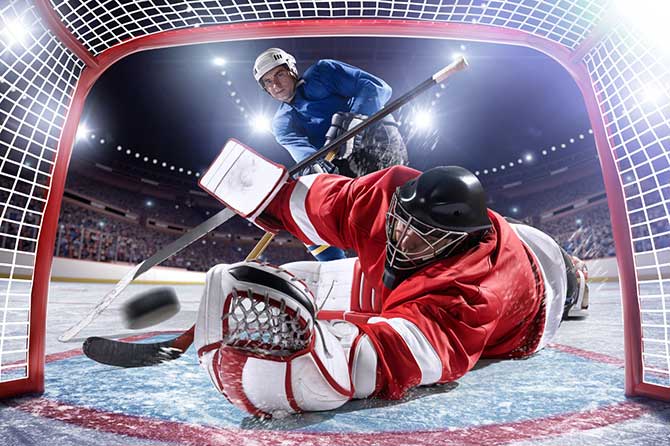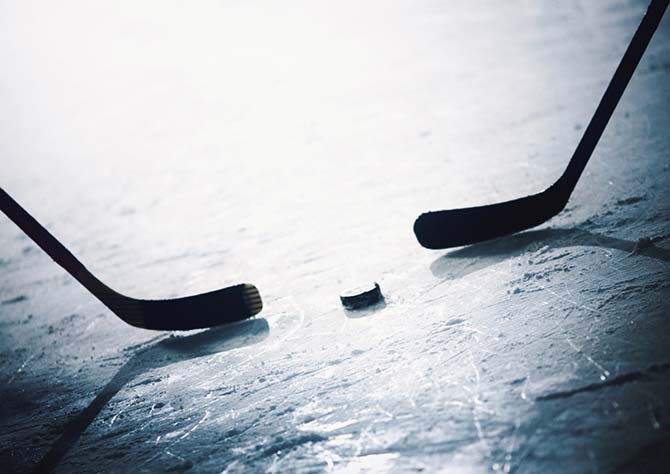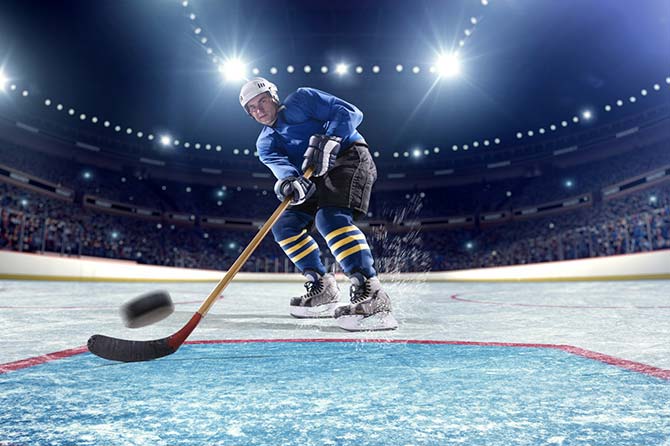Shooting in Ice Hockey: From the Slap Shot to the Snap Shot
Ice hockey professional Matthias Plachta from the Adler Mannheim helps you train your shot

Slap shots send the puck cruising at speeds over 100 mph. The puck is also able to fly over the ice at a high speed. The slap shot is pivotal in a game. In this article, we talked to the ice hockey professional Matthias Plachta. He explains not only which shooting techniques there are, but also which exercises help improve your technique.
Ice hockey - the fastest team sport in the world
First of all: Did you know that ice hockey is the fastest team sport in the world? Not only the players on the ice, but also the pucks that are fired reach top speeds that no other team sport can match.
In the following section we'll explain what shots there are, how and what muscles to train and why you should be careful of your teeth, especially when shooting.
The right shooting technique in ice hockey
Although in ice hockey the pucks fly through the air at incredible speeds, force is not the only decisive factor for a precise and accurate shot. The right technique, timing and speed are very important.
But what really makes a good shot? Matthias Plachta, professional player with the top German professional league team Adler Mannheim, is of the opinion that this is difficult to generalise. "There is no one recipe. Every ice hockey player has to find out for himself which technique is best for him. A hard, precise and fast shot is important", says the ice hockey expert. In his opinion, this is largely a matter of muscle memory.
In addition to the slap shot - probably the hardest shot in ice hockey - we will introduce you to the most important shots and explain when to use them.

The Slap Shot
The slap shot is the bread and butter of shooting. It's the hardest and quickest of the shots. The puck can reach incredible speeds of 100 mph.
A slap shot has four phases:
1. The player winds his stick, moving it backwards until it is parallel with the ground.
2. Next, the shooter swings the club down and forward. The end of the stick contacts the ice where the puck is. The player now shift his weight to the stick as it moves past the puck. The stick end will bend backwards as it makes contact with the puck.
3. The shooter then leads the stick forward while rotating the hips.
4. Focus on the target and use the stick to guide the puck where you want it to go.
Upon contact with the puck, the stick bends backwards, mimicing a tensioned bow. The puck then slaps fowards:
Since a large swinging motion is necessary to perform the shot, you'll need sufficient space and power along with precision and accuracy in order to transfer energy to the puck.
However: Strength alone is not enough. The trick is timing. Bring the stick back across your body outward. Now slap it towards the ice in front of the puck. The stick must hit the ice before the puck so that the stick bends backwards. Upon reaching the puck, the potential energy of the bent stick transfers the energy to the puck. The result is a blazing fast and hard shot.
Here, you can see what a correct slap shot looks like from different perspectives in slow motion and what forces work together to shoot the puck forwards. The sound is unmistakable. By the way: It's not uncommon for a hockey stick to break when performing a slap shot.
Back in the day: The Canadian NHL player Bernie Geoffrion caused a sensation when using this shot for the very first time. The shooting technique has been his trademark since 1951. Geoffrion's nickname "Boom Boom", for example, is derived from the sound of his particularly hard shots.
The Wrist Shot
The wrist shot is a shooting technique used in constrained spaces. The wrist shot has a surprising effect. The precision and fast execution often leave the goalie no chance.
A wrist shot can be fired quickly and accurately. To do so, the player makes a low swinging motion.
The stick is usually kept close to the puck. But when the player goes to shoot, he pulls the stick backwards to get ready to shoot the puck by flinging it forwards.
In the following video, Jeremy Rupke shows that a wrist shot is not only a matter of wrist rotation, but also a shift in balance and the awareness of position in relation to the puck. Jeremy Rupke runs the blog How to Hockey with the corresponding Youtube channel and shares his knowledge about hockey.
The Snap Shot
The snap shot is in principle a shortened wrist shot. Instead of taking the stick backwards across your body on the ice to wind up, you shoot in an attacking position with the puck in front of you. With the puck on your stick and the puck in front of you, pull the wrists back and then snap them forward to shoot the puck. The advantage of the snap shot is the element of surprise. Without a dramatic wind up, the goalie is usually unprepared to defend.
The snap shot is mainly used near the goal, because here it is very important that the puck is played as fast as possible. This shooting technique should be mastered by every experienced ice hockey player in order to use scoring chances effectively.
The ability to quickly shift weight and accuracy are the be-all and end-all of an effective snap shot. as Jeremy Rupke explains in detail in this video:
The Backhand Shot
The backhand is a shooting technique in which the puck is played with the back of the stick. If a player masters a strong and accurate shot with the backhand, this opens up a wide range of goal possibilities.
Although the backhand shot is less precise than the wrist shot, it can certainly cause confusion for the goalie. If the goalie doesn't see the shot being fired in time, it will be difficult for him to stop the puck and prevent the goal.
In addition, with thebackhand, timing is important: During a fast break there is often simply not enough room to change the guidance of the stick quickly. In this case, a targeted shot with the backhand is the best way to prevent a possible goal-scoring chance from simply being missed.
Jeremy Rupke summarises in detail what you should pay attention to when shooting backhand:
The Wrap Around
The wrap around allows you to score a goal very quickly and effectively.
The shooter moves quickly around the opponent's goal and attempts to score by reaching around the opposite side of the net. If the goalkeeper recognises the manoeuvre too late, the wrap around is an excellent chance to score a quick goal.
Here you can see the moment shortly before the shot is fired. The shooter is about to play the puck directly into the opposite corner, which is currently unprotected by the goalie:
By the way: Did you know that in Switzerland this special shooting technique is called Buebetrickli?
How can I improve my shot?
Since scoring a goal depends on the shot, stick handling is of utmost importance, which every player should learn and constantly improve. Condition, strength, speed and a quick reaction time are crucial.
Matthias Plachta from the Adler Mannheim notes that professional teams don't teach shooting: "Youngsters still train their shooting technique, over the summer or with special shooting trainers. After a certain age, however, shooting isn't trained anymore. After the team trainings we shoot some pucks every now and then. The players can train their shot if they feel it is weak."
Training on the ice: shoot, shoot, shoot
If you want to improve your shooting technique on the ice, the professional advises one thing: "There are shooting machines with which you can simulate any situation on the ice as well as any shot type and direction. But in the end you just have to shoot, shoot, shoot. To work a little on the hardness, there are special pucks that are a little heavier than the game pucks. But even with these, you should shoot hundreds, even thousands of pucks. Because the right technique is always a matter of feeling in the end."

Technique and strength are therefore the decisive factors for a successful scoring chance. In order to increase your potential on the ice, we recommend integrating reaction time training and situational awareness drills into your training. We'll show you what an effective training plan looks like.
Improving Shooting Power
In order to develop the necessary shooting power for wrist and snap shots, you should include plate pinchers, hex holds and wrist rolls regularly in your training. With appropriate weights, you can strengthen your hand muscles. Feel free to increase repititions or sets if needed. Also chin ups and push ups provide more power and strengthen your arms.
Improve Stick Handling
"Five minutes, five times a week", advises coach Jouni Lehtola of Hockey Club Dallas. For him, stick handling is crucially important. He is fond of giving his players this homework: five minutes, fives times a week.
Train with a mini stick. This ensures you can train at home or on the road anytime. Repitition is the key word: Muscle memory is born out of repitition, which can be used in games on the ice. Good stick handling helps you weave through players to give you a better scoring chance.
Holistic Workout for Ice Hockey Players
In order to improve shooting power and technique, comprehensive strength training is essential for the ambitious ice hockey player. It is important to train not only the arms and legs, but also the back and general coordination.
For example, a comprehensive Ice hockey workout may include squats for strong legs. For chest and triceps, however, bench press with dumbbells is suitable. Legs, glutes and core can be trained with a combination of step-ups and lunges . To help prepare you for everything on the ice, we recommend a strong core via planking.
The players of the EHC Red Bull Munich show what a targeted, functional and effective ice hockey training session looks like, which is also fun:
Nothing comes from nothing!
You won't master the slap shot overnight. The old saying "practice makes perfect" applies here too. Or as Matthias Plachta puts it: shoot, shoot, shoot.
So if you want to improve your shooting technique, you need to practice on every surface you can find. However, be sure to take holistic strength training into account. Train your legs, arms and back muscles so you can dominate the ice.
If you want to know how to take care of your hockey equipment or want to brush up on the rules of hockey, have a look at our magazine.
And if you're thinking of designing hockey jerseys for your team or yourself, use our 3D Designer to create your dream design.
Photos: Title Image: © gettyimages/Dmytro Aksonov, Image 1: © gettyimages/gilaxia, Image 2: © gettyimages/Dmytro Aksonov